© Copyright Atlanta Coin Expositions, 2008-2025. All Rights Reserved.
Several of the links on the pages within this web site go to affiliate vendors.
A vendor affiliation can mean a small monetary compensation to the web site owner at no additional cost to you.
Several of the links on the pages within this web site go to affiliate vendors.
A vendor affiliation can mean a small monetary compensation to the web site owner at no additional cost to you.
Coin Show
Information
Shop
General
Next Monthly Coin Show
Coin Show - Monthly Notes for September 2021
Mark your calendar and join us at the next show on Sunday, October 10, 2021 in the Joe Mack Wilson ballroom.
Once again, the show's bourse will contain displays of coins, currency, bullion, exonumia, scripophily, semi-precious stones, jewelry and other interesting items in the dealers' showcases.
Guests are welcome to visit the show from 9am to 5pm to buy, sell, trade or just look at the many different collectible and historical items the dealers provide for display each month.
People can also bring items such as coins, currency and bullion to the show for the dealers to provide free verbal appraisals.
In the event circumstances impact the show, check with this web site, the recorded show message (770-772-4359) or join our mailing list to receive information about the shows.
Make a reminder note and visit the next Greater Atlanta Coin Show on Sunday, October 10, 2021 in the Joe Mack Wilson ballroom to join the fun and view the items on the bourse.
Once again, the show's bourse will contain displays of coins, currency, bullion, exonumia, scripophily, semi-precious stones, jewelry and other interesting items in the dealers' showcases.
Guests are welcome to visit the show from 9am to 5pm to buy, sell, trade or just look at the many different collectible and historical items the dealers provide for display each month.
People can also bring items such as coins, currency and bullion to the show for the dealers to provide free verbal appraisals.
In the event circumstances impact the show, check with this web site, the recorded show message (770-772-4359) or join our mailing list to receive information about the shows.
Make a reminder note and visit the next Greater Atlanta Coin Show on Sunday, October 10, 2021 in the Joe Mack Wilson ballroom to join the fun and view the items on the bourse.
The September 2021 Greater Atlanta Coin Show welcomed many visitors to buy, sell, trade or just browse its bourse filled with dealers and their numismatic and collectible displays.
Though the calendar has not moved into fall yet, the weather presented the show attendees with a nice day in the low 80s and much nicer humidity levels.
But fall is definitely arriving as can be seen in the angle of the sun's rays and the bluer skies without the heat haze.
In other words, it was a beautiful day to be out and about and visiting a coin show.
Though the calendar has not moved into fall yet, the weather presented the show attendees with a nice day in the low 80s and much nicer humidity levels.
But fall is definitely arriving as can be seen in the angle of the sun's rays and the bluer skies without the heat haze.
In other words, it was a beautiful day to be out and about and visiting a coin show.
We thank all of the many guests who visited the show, the dealers who presented their displays, our security and the hotel's staff. All of you are important to the show and are appreciated.
This month, we had three first time dealers - welcome, we're glad you joined us and hope you enjoyed the show.
The September show missed a few of our regular dealers. Some were under the weather while others had schedule conflicts. That happens. They will return to the show soon.
This month, we had three first time dealers - welcome, we're glad you joined us and hope you enjoyed the show.
The September show missed a few of our regular dealers. Some were under the weather while others had schedule conflicts. That happens. They will return to the show soon.
Once again, many of the show's guests searched for silver and gold - some as bullion and some as coins.
Many of the dealers with gold sold out of the inventory they brought with them. Similarly, the dealers with silver sold most of what they had on display.
Now, let's take a look at a few as-seen-on-the-bourse items.
Many of the dealers with gold sold out of the inventory they brought with them. Similarly, the dealers with silver sold most of what they had on display.
Now, let's take a look at a few as-seen-on-the-bourse items.
Group of Gold
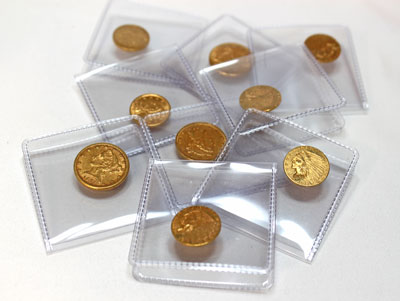
This handful of un-certified coins includes gold quarter and half eagle coins once used in circulation as legal tender.
The US Mint produced the gold quarter eagle ($2.50) from 1796 to 1929 using several different designs through years.
Similarly, they produced the gold half eagle ($5.00) beginning in 1795, one year earlier, and ending in 1929.
With minor differences, they kept the main obverse and reverse designs consistent between the quarter and half eagle gold coins, however several different varieties exist with changes in the minor design elements.
Let's take a look at three different coins.
The US Mint produced the gold quarter eagle ($2.50) from 1796 to 1929 using several different designs through years.
Similarly, they produced the gold half eagle ($5.00) beginning in 1795, one year earlier, and ending in 1929.
With minor differences, they kept the main obverse and reverse designs consistent between the quarter and half eagle gold coins, however several different varieties exist with changes in the minor design elements.
Let's take a look at three different coins.
In keeping with our guests' searches, this month let's highlight a few gold coins.
1906 Gold Quarter Eagle Coin
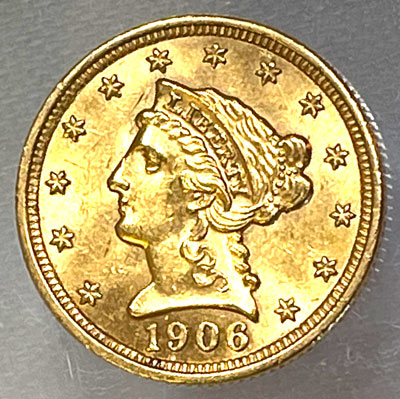
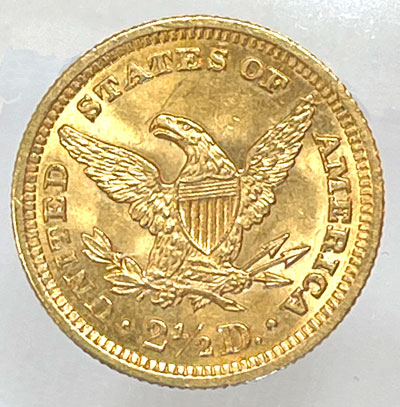
In 1834, their weight changed to 64.5 grains or 4.18 grams and .8992 fineness. The silver and copper content increased to 10.08 percent.
Just a few years later, 1837, the weight stayed at 4.18 grams but the fineness changed to .9000 or 90 percent gold and 10 percent copper.
The Philadelphia Mint produced this particular specimen in 1906 with a total population of 176,330 regular strikes and 160 proof coins.
Interestingly, the PCGS (Professional Coin Grading Service) CoinFacts estimates the surviving population to be 15,000 across all grades.
They go on to comment, "A common date. Generally available in uncirculated condition or proof."
Just a few years later, 1837, the weight stayed at 4.18 grams but the fineness changed to .9000 or 90 percent gold and 10 percent copper.
The Philadelphia Mint produced this particular specimen in 1906 with a total population of 176,330 regular strikes and 160 proof coins.
Interestingly, the PCGS (Professional Coin Grading Service) CoinFacts estimates the surviving population to be 15,000 across all grades.
They go on to comment, "A common date. Generally available in uncirculated condition or proof."
Congress initially authorized the gold quarter eagle coin by the Act of April 2, 1792.
The early quarter eagles weighed 67.5 grains or 4.37 grams with .9167 fineness. Their gold content was 91.67 percent with the remaining 8.33 percent being silver and copper.
The early quarter eagles weighed 67.5 grains or 4.37 grams with .9167 fineness. Their gold content was 91.67 percent with the remaining 8.33 percent being silver and copper.
"Pieces made at Charlotte, Dahlonega, and New Orleans are frequently found weakly struck. Weakly struck pieces are most common for 1853,1856, 1857S, 1859S, 1867S, 1869S and 1876S.
"Most coins after 1880 are well struck with sharp details.
"Coins will not always have the exact stated amount of mint luster, strike, or absence of marks.
"Overall eye appeal and appearance may also influence the stated grade."
This coin has not been certified by a grading agency, however, it does appear to have very little wear on either the obverse or reverse.
But, it takes a trained eye to know for sure where this coin falls in the grading scale.
"Most coins after 1880 are well struck with sharp details.
"Coins will not always have the exact stated amount of mint luster, strike, or absence of marks.
"Overall eye appeal and appearance may also influence the stated grade."
This coin has not been certified by a grading agency, however, it does appear to have very little wear on either the obverse or reverse.
But, it takes a trained eye to know for sure where this coin falls in the grading scale.
The ANA Grading Standards for the Liberty Head Gold Quarter Eagle produced 1840-1907 state:
"Coins of this type seldom appear in grades lower than Fine.
"Coins of this type seldom appear in grades lower than Fine.
It's a nice coin to own containing both gold and little bit of history at the same time.
1908 Gold Half Eagle Coin
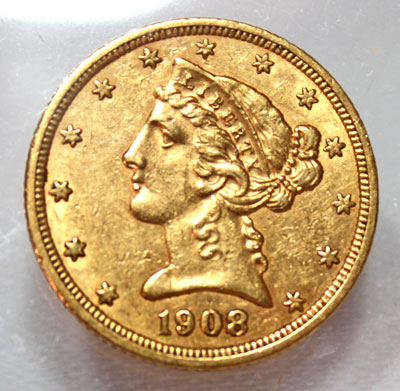
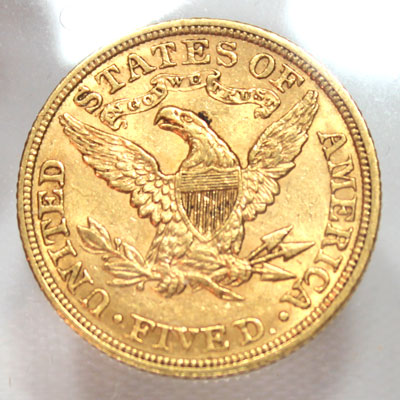
Similar to the quarter eagle the initial weight and fineness changed in 1834 and again in 1837.
The coin began at 8.75 grams with .9167 gold and .0833 silver and copper.
The weight reduced to 8.359 grams with .8992 gold and .1008 silver and copper with the last change being .9000 gold and .1000 copper.
Considering the US Mint in the modern era has produced gold quarter and half eagle coins as commemoratives or as bullion, the Red Book states that the half eagle is the only denomination to be minted at all eight US Mint locations.
One of the US Mint's well-known designers, Christian Gobrecht, developed this coin's Liberty Head design also used on the quarter eagle as seen above.
The coin began at 8.75 grams with .9167 gold and .0833 silver and copper.
The weight reduced to 8.359 grams with .8992 gold and .1008 silver and copper with the last change being .9000 gold and .1000 copper.
Considering the US Mint in the modern era has produced gold quarter and half eagle coins as commemoratives or as bullion, the Red Book states that the half eagle is the only denomination to be minted at all eight US Mint locations.
One of the US Mint's well-known designers, Christian Gobrecht, developed this coin's Liberty Head design also used on the quarter eagle as seen above.
Congress approved the Gold Half Eagle Coin in the same legislation as the quarter eagle.
Perhaps the Half Eagle at $5.00 per coin was needed more than the quarter eagle, because the US Mint produced the Gold Half Eagle one year earlier than the quarter eagle.
Perhaps the Half Eagle at $5.00 per coin was needed more than the quarter eagle, because the US Mint produced the Gold Half Eagle one year earlier than the quarter eagle.
Though more of these were produced than the quarter eagles, PCGS estimates only 10,000 of these coins across all grades have survived.
They also comment, "The 1908 Liberty Head is the last year of this long lived type and is one of the most common dates of the Half Eagle series. Many choice and gem quality examples are available."
Again, the ANA Grading Standards commented that these coins are not collected in less than a Fine grade.
This one does not have a certified grade, however it appears to not have much wear. Though, there do appear to be marks on the coin.
Regardless, it is a nice coin to collect for the gold, for the history, and for the low survival rate out of the initial production.
They also comment, "The 1908 Liberty Head is the last year of this long lived type and is one of the most common dates of the Half Eagle series. Many choice and gem quality examples are available."
Again, the ANA Grading Standards commented that these coins are not collected in less than a Fine grade.
This one does not have a certified grade, however it appears to not have much wear. Though, there do appear to be marks on the coin.
Regardless, it is a nice coin to collect for the gold, for the history, and for the low survival rate out of the initial production.
For the 1908 Gold Half Eagle, the last year for the design, the Philadelphia Mint struck 421,874 coins for circulation with no proof coins for this year.
1914 Gold Quarter Eagle Coin
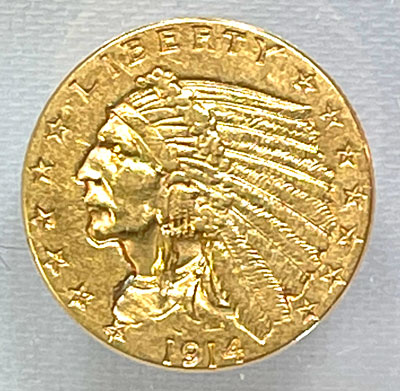
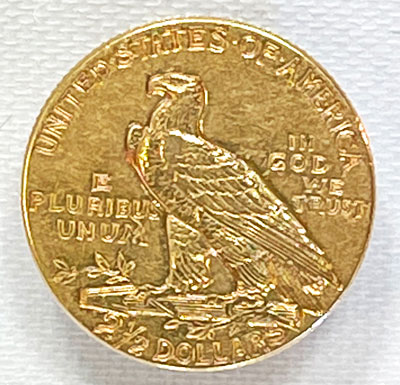
"Boston sculptor Bela Lyon Pratt was the designer of this and the similar half eagle piece. A pupil of the famous Augustus Saint-Gaudens, Pratt based his 'standing eagle' motif on the reverse of his teacher's gold ten-dollar coin of 1907."
The PCGS website adds more commentary about the recessed design elements:
"The new Indian quarter eagle and half eagle of 1908 represented an innovation in American coinage.
"The designs were incuse or inset in the surface, with the field of the coin, normally the lowest part, being in the present instance the highest part. Incuse coins had been made in ancient times, but never before in circulating United States issues.
The PCGS website adds more commentary about the recessed design elements:
"The new Indian quarter eagle and half eagle of 1908 represented an innovation in American coinage.
"The designs were incuse or inset in the surface, with the field of the coin, normally the lowest part, being in the present instance the highest part. Incuse coins had been made in ancient times, but never before in circulating United States issues.
Our third and last coin of this month is one of the last designs for the Gold Quarter Eagle Coin
The US Mint produced this design beginning in 1908 and ending at the end of circulation production in 1929.
The Red Book provides interesting commentary on this coin's design:
"This new type presents a departure from all precedents in United States coinage. Its design features no raised edge, and the main devices and legends are in sunken relief below the surface of the coin.
The US Mint produced this design beginning in 1908 and ending at the end of circulation production in 1929.
The Red Book provides interesting commentary on this coin's design:
"This new type presents a departure from all precedents in United States coinage. Its design features no raised edge, and the main devices and legends are in sunken relief below the surface of the coin.
Perhaps the incused design presents difficulty in grading.
The ANA Grading Standards notes:
"These coins often show minor weaknesses or friction spots even though they may never have been used in circulation.
"Such coins are difficult to distinguish and are sometimes considered to be Mint State rather than About Uncirculated, when they have superior eye appeal, strike or appearance."
In 1914, the Philadelphia and Denver Mints produced the Gold Quarter Eagle Coins.
Philadelphia produced this coin as one of 240,000 circulation strikes.
The ANA Grading Standards notes:
"These coins often show minor weaknesses or friction spots even though they may never have been used in circulation.
"Such coins are difficult to distinguish and are sometimes considered to be Mint State rather than About Uncirculated, when they have superior eye appeal, strike or appearance."
In 1914, the Philadelphia and Denver Mints produced the Gold Quarter Eagle Coins.
Philadelphia produced this coin as one of 240,000 circulation strikes.
"Curiously and inconsistently, Indian quarter eagles and half eagles struck at Denver and San Francisco (half eagles, but not quarter eagles, were struck at New Orleans as well), with mintmarks, bore the mintmark raised on the coin - extending above the field.
"Apparently it was too much trouble to have the mintmark incuse. This is probably just as well, for one can imagine a proliferation of phony mintmarks made for collectors, by punching D and S letters into the fields of Philadelphia Mint coins!"
"Apparently it was too much trouble to have the mintmark incuse. This is probably just as well, for one can imagine a proliferation of phony mintmarks made for collectors, by punching D and S letters into the fields of Philadelphia Mint coins!"
Today, PCGS estimates 15,666 of the Philadelphia minted circulation coins remain across all grades.
This coin provides an interesting look at the innovation the Mint willingly accepted for these gold coins.
This coin is a small but fun piece of gold to collect and admire.
This coin provides an interesting look at the innovation the Mint willingly accepted for these gold coins.
This coin is a small but fun piece of gold to collect and admire.
